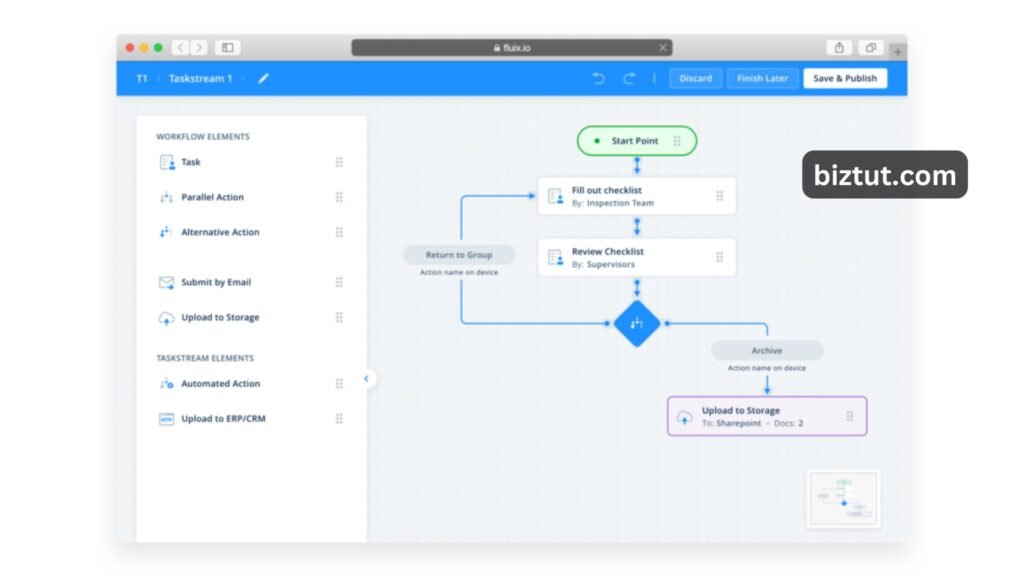Workflows are flexible and customizable tools that businesses of all sizes can use to boost efficiency, productivity, and project management while ensuring consistency and compliance.
Think of a workflow as a roadmap. It outlines a clear series of steps to manage a process from start to finish. Workflows that are properly built can help businesses reduce expenses and maintain their competitiveness in a world that is changing quickly.
In this article, we’ll define what a workflow is and look at some key principles and strategies for creating an effective workflow process.
Understanding Workflow Basics
Here are some reasons why companies might want to add workflow automation to their operations:

- The business has grown: As the amount of work increases, it’s crucial to make sure your processes are running smoothly and efficiently.
- Employees are frustrated: Unnecessary steps can confuse and frustrate employees. If these issues aren’t addressed, workers may feel undervalued and might even consider “quiet quitting.”
- Your service or product has changed: You need to reevaluate which old processes no longer fit your new offerings.
- Progress has slowed down: There could be a bottleneck somewhere in the workflow that’s causing delays.
- Communication issues are increasing: If you notice more mistakes and people seem out of the loop, it’s a sign that your workflow could use some improvement.
If any of these issues sound familiar, it might be time to upgrade your workflow!
How to Write a Workflow: Key Things to Consider

If you want to create a workflow process that works the same for everyone in your company and helps tasks get done more smoothly, you’ll need to document and test it. Here are three simple steps to make writing it easier:
1. Analyze Current Resources and Processes
Start by figuring out who is involved in each step of the task and what they need to succeed. If you don’t have this information, spend some time watching how the task is done from start to finish.
Talk to the people involved and ask if there are parts that seem too complicated or if there are tools that could help simplify the process.
2. Outline Your Workflow Steps
Next, write down the steps for creating the workflow in detail. You might go through several drafts as you make changes and get feedback. Make sure to involve the people who will use the workflow daily and adjust the steps to keep things simple and efficient.
This mapping phase is really important for laying a solid foundation for your workflows and showing that you care about your employees’ needs.
3. Consider Integration Needs
Think about how different tools will work together when designing your workflow. If you’re using various systems like a CRM, data collection tool, and analytics software, integrating them can help everything flow smoothly. This way, you won’t have to do manual data entry, which reduces mistakes.
Also, integration helps save costs and resources by cutting down on repetitive tasks. It ensures your system works well with what you already have and supports growth as your organization expands.
How to Create a Workflow in 10 Steps
Workflows can really help reduce bottlenecks and boost productivity, as long as they’re designed well and fit your business needs.

Even if you’re new to creating workflows or using automation, modern tools like Fluix make it easy to get started with their user-friendly interface and step-by-step guidance.
Many workflow automation tools also come with pre-built templates for common processes. Check these out to see how workflows are organized and get inspiration for your own projects.
Learning from examples of workflows in your industry can also be helpful. These examples show how others have successfully implemented automation, and you can find some later in this article.
Here’s a simple 10-step approach to creating effective workflows that align with your business goals:
1. Define Your Goals
Start by understanding what you want to achieve with your workflow. Knowing your goals will help you customize the workflow to meet your needs and set clear expectations and deadlines.
2. Identify Processes to Optimize First
Break your main goal into smaller tasks. For example, if you’re automating the onboarding process, the steps might include collecting documents, training, IT setup, and HR orientation.
3. Analyze the Current Process
To write a good workflow, you need to understand how things work now and where the bottlenecks are. Document your existing processes so you have a clear starting point.
4. Identify Bottlenecks
Look for any redundancies and inefficiencies based on your analysis. Get feedback from team members involved in these processes and consider their suggestions for improvements.
5. Define Responsibilities
Clearly outline what each team member’s role is in the workflow. This helps everyone understand their responsibilities, reduces confusion, and makes it easier to hold people accountable.
6. Choose an Easy-to-Use Workflow Tool
Pick the right tools and software to support your workflow. Seek out digital solutions that enable you to store and retrieve documents as well as establish workflows that guarantee the completion of smaller chores before completing the primary goal.
7. Design a Step-by-Step Workflow
Now it’s time to create a test workflow using all the steps you outlined. Use your chosen tool to set up the workflow and run through a mock process. This will help you see if the tool meets your needs and if the steps flow smoothly.
8. Test the New Workflow
Have your team use the new system and provide feedback. It’s normal for minor issues to arise during testing. Go back to the design phase to implement any solutions you come up with. You might spend some time adjusting before rolling it out to the entire company.
9. Train Your Team
Once your workflow is ready, train your team on how to use it. If it’s a new automated system, they’ll need guidance on how it works and their role in the process. This upfront investment in training will pay off with a more streamlined workflow in the long run.
10. Monitor Progress
After the workflow is up and running, set up a system to track its performance. Collect data, gather feedback, and regularly check how well the workflow is working. Use this information to make ongoing improvements.
Remember, the steps in your workflow may vary depending on your industry and the specific processes you’re automating. They might also include risk analysis, integrations, or plans for scaling up to handle more work.
Workflow Examples
Let’s explore some workflow examples to see how they’re used in different industries and tasks.
1. Punch List Workflow
The punch list workflow is the final check before wrapping up a project. It involves creating a checklist of small tasks or issues that need fixing.
Goal: Wrap up projects by taking care of minor issues.
Steps: Make a checklist, identify tasks, fix issues, fine-tune details, and hand over the project.
Who’s Involved: Project managers, contractors, and the quality assurance team.
2. Quality Inspection Workflow
This workflow is all about making sure products or processes meet specific standards through a series of checks and tests.
Goal: Ensure everything meets quality standards.
Steps: Conduct checks and tests, follow strict quality control procedures, maintain consistency, and meet customer expectations.
Who’s Involved: QA inspectors, production team, and compliance officers.
3. Employee Onboarding Workflow
The employee onboarding workflow helps welcome new team members by automating everything from paperwork to training sessions.
Goal: Help new employees fit into the company culture.
Steps: Submit documentation, hold training sessions, provide necessary information and resources, and offer IT support.
Who’s Involved: HR team, managers, and new hires.
4. Equipment Inspection Workflow
This workflow is designed to find potential issues, ensure safety compliance, and schedule maintenance for equipment.
Goal: Keep operations running smoothly and safely with regular checks.
Steps: Assess machinery, identify potential problems, ensure safety compliance, schedule maintenance, and prevent breakdowns.
Who’s Involved: Maintenance team, equipment operators, and safety officers.

5. Capex Approval Workflow
The Capex approval workflow outlines a clear process for approving significant investments to make sure they align with the company’s goals and budget.
Goal: Protect company finances with a structured approval process.
Steps: Submit investment proposals, review them, get approvals, and ensure spending matches organizational goals.
Who’s Involved: Finance department, senior management, and project managers.
6. Safety Toolbox Talk Workflow
This workflow encourages open discussions about safety protocols, focusing on specific topics and best practices.
Goal: Make safety a priority through open conversations.
Steps: Hold brief, focused meetings, discuss specific safety topics, ensure everyone is informed, and reduce potential risks.
Who’s Involved: Safety officers, team leaders, and all employees.
These examples show how systematic approaches can boost efficiency, ensure compliance, and contribute to success in various organizational processes.




